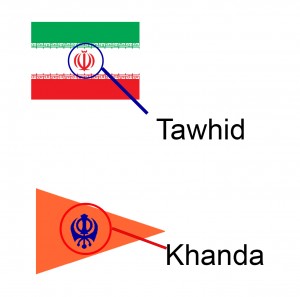In the image we have two flags here Iran flag and Khalsa flag both have a emblem marked in the center with names of tawhid and khanda
according to wiki pedia
Tawhid the emblem on Iran flag :-
The parliament, per the 1980 constitution, changed the flag and seal of state insofar as the Lion and Sun were replaced by the red emblem in the centre of the flag. Designed by Hamid Nadimi, and officially approved by Parliament and the Leader Grand-Ayatollah Khomeini on 9 May 1980, this Emblem is a highly stylized composite of various Islamic elements: a geometrically symmetric form of the word Allah ("God") and overlapping parts of the phrase lā ʾilāha ʾillà l-Lāh, (There is no God Except Allah), forming a monogram in the form of a tulip it consists of four crescents and a line. The four crescents read from right to left; the first crescent is the letter aleph, the second crescent is the first laam; the vertical line is the second laam, and the third and fourth crescents together form the heh. Above the central stroke is a tashdid (a diacritical mark indicating gemination) resembling "W". The tulip shape of the emblem as a whole memorializes those who have died for Iran and symbolizes the values of patriotism and self-sacrifice, building on a legend that red tulips grow from the shed blood of martyrs. This emblem is somewhat similar to the Khanda but has no relation to Sikhism and its meaning to that religious community.
The logo is encoded in Unicode, in the Miscellaneous Symbols range, at codepoint U+262B (☫) under the name "FARSI SYMBOL".
Khanda the emblem of the Khalsa flag :-
The Khanda (Punjabi: ਖੰਡਾ, khaṇḍā) depicts the Sikh doctrine Deg Tegh Fateh in emblematic form. It is the military emblem of the Sikhs. It is also part of the design of the Nishan Sahib. A double edged khanda (sword) is placed at the top of a Nishan Sahib flag as an ornament or finial. The Khanda emblem is an amalgam of three symbols, represented by three different items.
• A double-edged khanda (sword) in the centre
• A chakkar (chakram)
• Two single-edged swords, or kirpan, crossed at the bottom and sit on either side of the khanda and chakkar. They represent the dual characteristics of Miri-Piri, indicating the integration of both spiritual and temporal sovereignty together and not treating them as two separate and distinct entities.
The Khanda is often confused with the emblem shown on Iran's flag which the Khanda predates. In recent years, the Khanda has been used to show solidarity within the Sikh community after high profile shootings in the united States.
The symbol is encoded in Unicode, in the Miscellaneous Symbols range, at codepoint U+262C (☬).
Article:-
The use of Khanda is dated back to 1849 as the symbol worn by Sikhs in one form or the other whereas Tawhid is dated to 9 may 1980 ,In accordance with the evidence available we can't say if they have any link but they nearly resemble each other. No evidence is available as on date to prove them to be the same or copy of each other or vice-verse .


